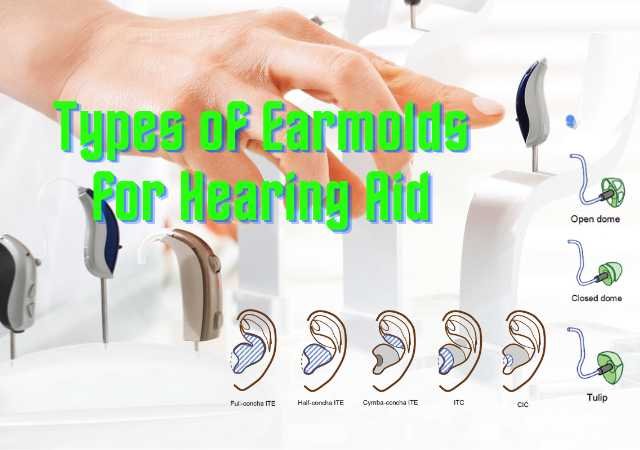Procedure for Selecting Earmold and Earshell: When it comes to optimizing the acoustic performance of hearing aids, the selection of Earmold and Earshell Types plays a pivotal role in achieving the desired outcomes. Understanding the diverse options available and the considerations involved in the decision-making process is essential for both audiologists and individuals seeking hearing solutions. This article delves into the procedural aspects of selecting earmolds and earshells, providing a comprehensive guide through five key steps. From determining the maximum and minimum vent sizes based on feedback issues and occlusion effects to choosing a sound bore profile and optimal damper selection, each step contributes to a tailored and effective hearing aid fitting. The inclusion of detailed tables, such as those illustrating the maximum possible insertion gain and the typical effect of dampers, enhances the practical applicability of the guidelines presented. Whether you are a clinician navigating the complexities of hearing aid customization or an individual exploring the nuances of hearing solutions, this article aims to shed light on the intricacies of earmold and earshell selection.
Procedure for Selecting Earmold and Earshell
You can employ the subsequent guidelines to determine appropriate earmold acoustics before installing the hearing aid. This process presupposes that a preliminary decision has been made for the remaining components of the hearing aid. Occasionally, executing these steps may reveal that the initial decision was not optimal, prompting a need for a reconsideration and a new selection.
Step 1: Determine the maximum feasible vent size
Calculate the target insertion gain and refer to one of the provided tables 1, 2, and 3 to identify the maximum vent size that can be employed without encountering feedback issues. For nonlinear hearing aids, utilize the target gain for low-level inputs since the gain is most significant for such inputs. Keep in mind to incorporate an additional allowance, such as 15 dB, if feedback cancellation is enabled, and deduct a safety factor, perhaps 7 dB.
| Table 1: The Maximum possible insertion gain (in dB) without causing feedback oscillation in Behind the Ear (BTE) hearing aids is investigated when connected to hard acrylic earmolds featuring vents of varying sizes. These findings represent averaged results from ten subjects. Increased insertion gains can be achieved by using snug earmolds, employing softer earmold materials, and implementing feedback cancellation algorithms. | |||||||||
| Vent Size | Vent Acoustic Mass (Henrys) | Frequency (Hz) | |||||||
| 500 | 750 | 1000 | 1500 | 2000 | 3000 | 4000 | 6000 | ||
| Occluded average fit | 65 | 66 | 64 | 60 | 56 | 41 | 45 | 50 | |
| 1 mm | 26,700 | 65 | 64 | 61 | 58 | 52 | 39 | 45 | 47 |
| 2 mm | 7,000 | 60 | 60 | 57 | 54 | 49 | 36 | 41 | 48 |
| 3.5 mm | 2,400 | 51 | 53 | 52 | 48 | 43 | 31 | 35 | 41 |
| Tube | 800 | 41 | 43 | 42 | 40 | 34 | 23 | 26 | 37 |
| Open dome | 830 | 55 | 49 | 42 | 39 | 31 | 19 | 27 | 30 |
| Table 2: The Maximum possible insertion gain (in dB) without causing feedback oscillation in ITE hearing aids with various vent sizes have specialized construction for occluded tight shells. The unique build-up during shell construction enables higher insertion gains, particularly when utilizing feedback cancellation algorithms. | ||||||||||
| Vent Size | Vent Acoustic Mass (Henrys) | Frequency (Hz) | ||||||||
| 250 | 500 | 750 | 1000 | 1500 | 2000 | 3000 | 4000 | 6000 | ||
| Occluded tight fit | 62 | 56 | 56 | 56 | 47 | 41 | 23 | 24 | 12 | |
| Occluded average fit | 62 | 54 | 52 | 49 | 44 | 33 | 24 | 22 | 13 | |
| 1.5 mm | 14,200 | 61 | 57 | 54 | 53 | 48 | 37 | 26 | 25 | 15 |
| 2 mm | 8,000 | 54 | 50 | 46 | 46 | 42 | 33 | 24 | 23 | 13 |
| IROS | 4,700 | 44 | 42 | 40 | 38 | 38 | 32 | 19 | 16 | 12 |
| Janssen | 2,100 | 42 | 41 | 40 | 39 | 36 | 31 | 17 | 16 | 13 |
| Table 3: The Maximum possible insertion gain (in dB) without causing feedback oscillation in ITC hearing aids include vents of various sizes. The tightly sealed shells during construction have a unique build-up. Feedback cancellation algorithms allow for increased insertion gains. | ||||||||||
| Vent Size | Vent Acoustic Mass (Henrys) | Frequency (Hz) | ||||||||
| 250 | 500 | 750 | 1000 | 1500 | 2000 | 3000 | 4000 | 6000 | ||
| Occluded tight fit | 58 | 52 | 49 | 52 | 45 | 39 | 31 | 33 | 13 | |
| Occluded average fit | 52 | 48 | 44 | 45 | 42 | 37 | 23 | 28 | 11 | |
| 1.5 mm | 14,700 | 47 | 47 | 44 | 45 | 39 | 34 | 28 | 31 | 12 |
| 2 mm | 7,800 | 44 | 41 | 38 | 38 | 38 | 32 | 21 | 27 | 17 |
| IROS | 4,500 | 39 | 34 | 31 | 31 | 29 | 26 | 15 | 23 | 7 |
Step 2: Determine the minimum required vent size
Based on the patient’s hearing thresholds at 250 and 500 Hz, make an estimation of the minimum vent size necessary to address the occlusion effect. While comprehensive research data on this matter is lacking, it is suggested that low-frequency losses exceeding 50 dB may not necessitate a vent. For losses below 30 dB at low frequencies, it is recommended to have a vent of at least 2 mm, preferably larger. Although a 1 mm vent typically has minimal impact on occlusion, its inclusion facilitates the clinician’s ability to enlarge the vent through drilling or grinding if deemed necessary.
Step 3: Determining the appropriate vent size
Based on the constraints identified in steps 1 and 2, this decision is straightforward for many patients. Typically, the maximum and minimum vent sizes will either be equal or have a slight difference, making the choice easy. However, challenges may arise for patients with nearly normal low-frequency hearing thresholds but a 60 to 90 dB loss in the high frequencies. In such cases, the maximum vent size may be smaller than the minimum, presenting a more intricate fitting process that may necessitate feedback-canceling algorithms.
For patients with challenging audiograms, it is advisable to consider ordering adjustable vents. Additionally, it may be worthwhile to opt for adjustable vents for individuals where the difference between the minimum and maximum vent sizes is not substantial. Similarly, for hearing aids with canal fittings, rather than earmolds, there are choices regarding the degree of openness in the fitting. If needed, the fitting can be modified without changing the hearing aid itself. If Step 3 results in selecting an open-canal fitting, Step 4 may be unnecessary, as cosmetic considerations would recommend using a thin-tube bore, eliminating the need for choosing horns or constrictions.
Step 4: Choosing a sound bore profile
Step 4 involves choosing a sound bore profile, with a focus on earmolds for BTE hearing aids due to the limited efficacy of horns for RIC/ITE/ITC/CIC hearing aids. The selection of the sound bore for these aids is typically handled by the manufacturer. For BTEs, the sound bore significantly influences the response shape in the 2 kHz to 4 kHz octave range. Therefore, the selection process can primarily consider these frequencies.
Begin by calculating the slope (in dB/octave) of the coupler gain target, which involves subtracting the 2 kHz target gain from the 4 kHz target gain. Subsequently, determine the maximum slope of the coupler gain for the chosen hearing aid. If the target slope is steeper than the hearing aid slope (which is often the case), a horn is necessary. In rare instances where the target slope is lower than the hearing aid gain slope, a constriction is required. If both slopes are approximately the same, a #13 tube is suitable. Refer to the following Table 4 to aid in the decision-making process, matching the sound bore configuration slope in the 2 to 4 kHz octave with the calculated discrepancy between the target slope and the hearing aid’s slope.
Note that the Lybarger high-pass tube achieves its slope by suppressing mid-frequencies relative to a #13 tube, as indicated in the following table. Additionally, the 1.5 LP tube affects the cut from 500 Hz to 2 kHz, having minimal impact on the slope above 2 kHz. If you opt for a straightforward rule, such as selecting the largest horn that fits in the ear canal without calculations, you will usually make the correct choice.
Table 4: Sound bore profile needed to resolve a discrepancy between a target response slope (calculated as 4 kHz gain minus 2 kHz gain) and the response slope available from the hearing aid in a coupler.
| Sound bore profile | 2 to 4 kHz slope (dB/octave) |
| Libby 4 mm horn | 12 |
| Libby 3 mm horn | 4 |
| CFA #2 horn | 7 |
| CFA #3 stepped bore | 7 |
| Lybarger high-pass tube | 11 |
| #13 glued-tube | -1 |
| 6C5 | -6 |
| 6C10 | -7 |
| 1.5 LP tube | -1 |
| Table 5: Effect on gain and OSPL90 (in dB) of various sound bore profiles relative to a #13 (2 mm) tube of truly constant diameter, for the same receiver | |||||||||
| Sound bore | Frequency (Hz) | ||||||||
| 250 | 500 | 750 | 1000 | 1500 | 2000 | 3000 | 4000 | 6000 | |
| Libby 4 mm | -1 | -2 | -3 | -3 | -1 | -2 | 6 | 10 | 6 |
| Libby 3 mm | -1 | -1 | -2 | -2 | 1 | 1 | 5 | 5 | 2 |
| CFA #2 horn | 0 | 0 | -1 | -1 | 0 | -1 | 4 | 6 | 4 |
| CFA #3 stepped bore | 0 | 0 | -1 | -1 | 0 | -1 | 4 | 6 | 2 |
| Lybarger high-pass tube | 2 | 4 | 0 | -11 | -13 | -12 | -10 | -1 | -1 |
| 6C5 | 0 | 1 | 0 | 0 | 0 | 0 | -4 | -6 | -11 |
| 6C10 | 0 | 2 | 0 | -2 | -1 | -5 | -10 | -12 | -17 |
| 1.5 LP | 1 | 3 | 0 | -9 | -10 | -9 | -10 | -10 | -12 |
| Thin-tube (0.9 mm) | 0 | 1 | 4 | 3 | -7 | -8 | -4 | -5 | -8 |
| RITC | -1 | -4 | -5 | -7 | -10 | -6 | -3 | -6 | -6 |
If the choice of a hearing aid and earmold relies on insertion gain rather than coupler gain, above Table 5 remains applicable for determining the appropriate sound bore. In such instances, determine the selection by comparing the target insertion gain slope with the anticipated insertion gain slope for the selected hearing aid.
Step 5: Choose a damper
Optimal damper selection is most effectively done after the hearing aid has been properly fitted. This is primarily because the following Table does not provide information on the damper’s impact on frequencies between the audiometric frequencies. Additionally, the specific effects of dampers at a given frequency can vary depending on whether that frequency aligns with a peak or trough. Moreover, the peaks and troughs in the insertion gain response of a hearing aid are contingent on the shape of the individual’s real-ear unaided response. Unlike a vent or a sound bore profile, the size of a damper can be adjusted during a fitting appointment within a few seconds. Therefore, it appears most convenient to initially measure the real-ear gain using the standard damper that comes with the hearing aid and subsequently adjust the damper as necessary, guided by the data in the following table 6 and the information in the panel titled “Shaping a BTE mid-frequency response with damping.”
| Table 6: The typical effect of the dampers placed at the nub or tip end of the earhook of a BTE hearing aid. Values shown are averages across several hearing aids; the attenuation varies slightly from hearing aid to hearing aid. The colors are the coding system used by Knowles Inc. Other values available are 1000 ohms (brown), 3300 ohms (orange), and 4700 ohms (yellow). | ||||||||||
| Damper impedance (ohms) | Damper position | Frequency (Hz) | ||||||||
| 250 | 500 | 750 | 1000 | 1500 | 2000 | 3000 | 4000 | 6000 | ||
| 330 (gray) | Nub | 0 | 0 | 0 | -1 | -1 | -1 | -1 | 0 | 0 |
| 680 (white) | Nub | 0 | -1 | -1 | 3 | 0 | -1 | -1 | 0 | 0 |
| 1500 (green) | Nub | -1 | -2 | -3 | -7 | -1 | -2 | -4 | -1 | -1 |
| 2200 (red) | Nub | -1 | -1 | -2 | -6 | 0 | -3 | -3 | -4 | -1 |
| 330 (gray) | Tip | 0 | 0 | -1 | -3 | -1 | -1 | 0 | -1 | 0 |
| 680 (white) | Tip | 0 | 0 | -2 | -6 | -1 | -1 | -1 | -1 | -1 |
| 1500 (green) | Tip | -1 | -2 | -6 | -11 | -3 | -1 | -2 | -4 | -1 |
| 2200 (red) | Tip | -3 | -4 | -9 | -16 | -4 | -1 | -1 | -5 | -1 |
Conclusion: Procedure for Selecting Earmold and Earshell
In conclusion, the procedure outlined for selecting earmold and earshell components for hearing aids provides a systematic approach to optimizing acoustic performance. The stepwise process, encompassing determination of maximum feasible vent size, calculation of minimum required vent size, consideration of patient-specific factors, choice of sound bore profile, and selection of an optimal damper, ensures a comprehensive and tailored fit. The provided tables offer valuable insights into insertion gain, vent size, and sound bore profiles for various hearing aid configurations, aiding clinicians in making informed decisions.
Moreover, the emphasis on flexibility, such as the recommendation of adjustable vents for challenging audiograms, reflects the adaptability of the procedure to diverse patient needs. By integrating these guidelines into clinical practice, audiologists and clinicians can enhance the effectiveness of hearing aid fittings, ultimately improving the auditory experience for individuals with hearing loss. The detailed approach presented here serves as a valuable resource for navigating the complexities of earmold and earshell selection, contributing to the overall success of hearing aid interventions.
FAQs about the Procedure for Selecting Earmold and Earshell
1. What is the significance of determining the maximum feasible vent size, and how can it be calculated?
Answer: The maximum feasible vent size is crucial in preventing feedback issues in hearing aids. To calculate it, determine the target insertion gain and refer to tables 1, 2, and 3 provided in the article. These tables specify the maximum vent size based on the hearing aid type and patient parameters.
2. How do you estimate the minimum required vent size to address the occlusion effect?
Answer: Estimate the minimum required vent size by considering the patient’s hearing thresholds at 250 and 500 Hz. For losses below 30 dB at low frequencies, it is recommended to have a vent of at least 2 mm. However, for losses exceeding 50 dB, a vent may not be necessary. The article suggests considering a 1 mm vent to facilitate adjustments if needed.
3. What challenges may arise in determining the appropriate vent size, and how can they be addressed?
Answer: Challenges may arise for patients with nearly normal low-frequency hearing but a significant loss in high frequencies. In such cases, choosing an adjustable vent is advisable. Additionally, for hearing aids with canal fittings, decisions regarding the degree of openness can be modified without changing the hearing aid itself.
4. Why is the selection of a sound bore profile important, and how is it determined for BTE hearing aids?
Answer: The sound bore profile is crucial for shaping the response of BTE hearing aids. It is determined by calculating the slope of the coupler gain target and comparing it with the hearing aid’s slope. The article provides Table 4 to aid in choosing the appropriate sound bore profile based on the discrepancy between target and hearing aid slopes.
5. When should the damper selection be done, and why is it important?
Answer: Damper selection is most effectively done after the hearing aid has been properly fitted. The article suggests measuring the real-ear gain using the standard damper initially and adjusting it as necessary. Damper selection is important for shaping the mid-frequency response of BTE hearing aids, and Table 6 provides information on the typical effects of dampers at different frequencies.
References:
- Hearing Aids – Harvey Dillon (Book)
- Essentials of Audiology – Stanley A. Gelfand, PhD (Book)







Can u send subjective and objective tests in audiology plzzzz…
Wait for sometime I am writing on it
Can u send speech audiometry material